TOYOTA SUPRA 2022 User Guide
Manufacturer: TOYOTA, Model Year: 2022, Model line: SUPRA, Model: TOYOTA SUPRA 2022Pages: 498, PDF Size: 104.06 MB
Page 11 of 498
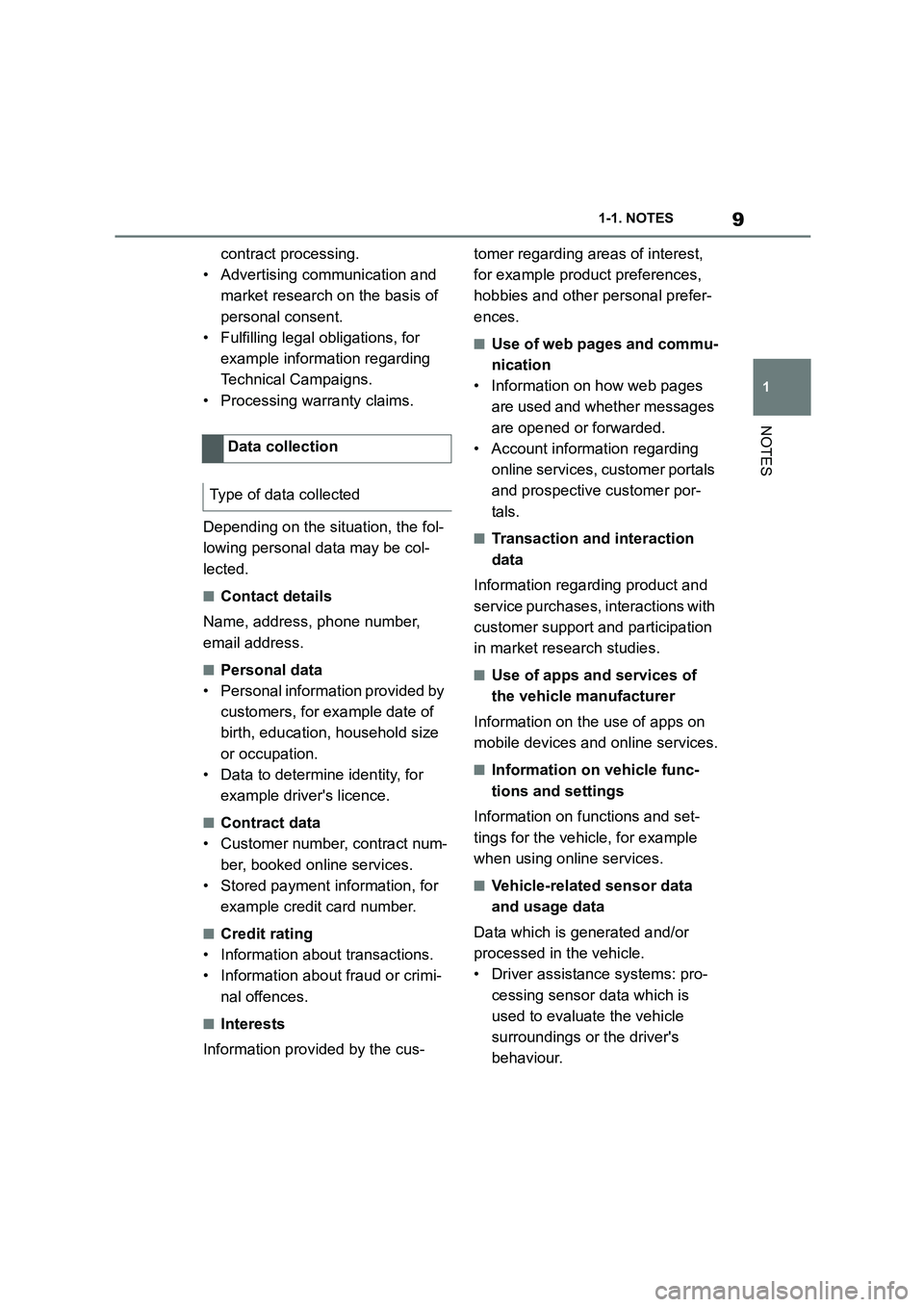
9
1
1-1. NOTES
NOTES
contract processing.
• Advertising communication and
market research on the basis of
personal consent.
• Fulfilling legal obligations, for
example information regarding
Technical Campaigns.
• Processing warranty claims.
Depending on the situation, the fol-
lowing personal data may be col-
lected.
■Contact details
Name, address, phone number,
email address.
■Personal data
• Personal informat ion provided by
customers, for example date of
birth, education, household size
or occupation.
• Data to determine identity, for
example driver's licence.
■Contract data
• Customer number, contract num-
ber, booked online services.
• Stored payment information, for
example credit card number.
■Credit rating
• Information about transactions.
• Information about fraud or crimi-
nal offences.
■Interests
Information provided by the cus-
tomer regarding areas of interest,
for example product preferences,
hobbies and other personal prefer-
ences.
■Use of web pages and commu-
nication
• Information on how web pages
are used and whether messages
are opened or forwarded.
• Account information regarding
online services, customer portals
and prospective customer por-
tals.
■Transaction and interaction
data
Information regarding product and
service purchases, interactions with
customer support and participation
in market research studies.
■Use of apps and services of
the vehicle manufacturer
Information on the use of apps on
mobile devices and online services.
■Information on vehicle func-
tions and settings
Information on functions and set-
tings for the vehicle, for example
when using online services.
■Vehicle-related sensor data
and usage data
Data which is generated and/or
processed in the vehicle.
• Driver assistance systems: pro-
cessing sensor data which is
used to evaluate the vehicle
surroundings or the driver's
behaviour.
Data collection
Type of data collected
Page 12 of 498
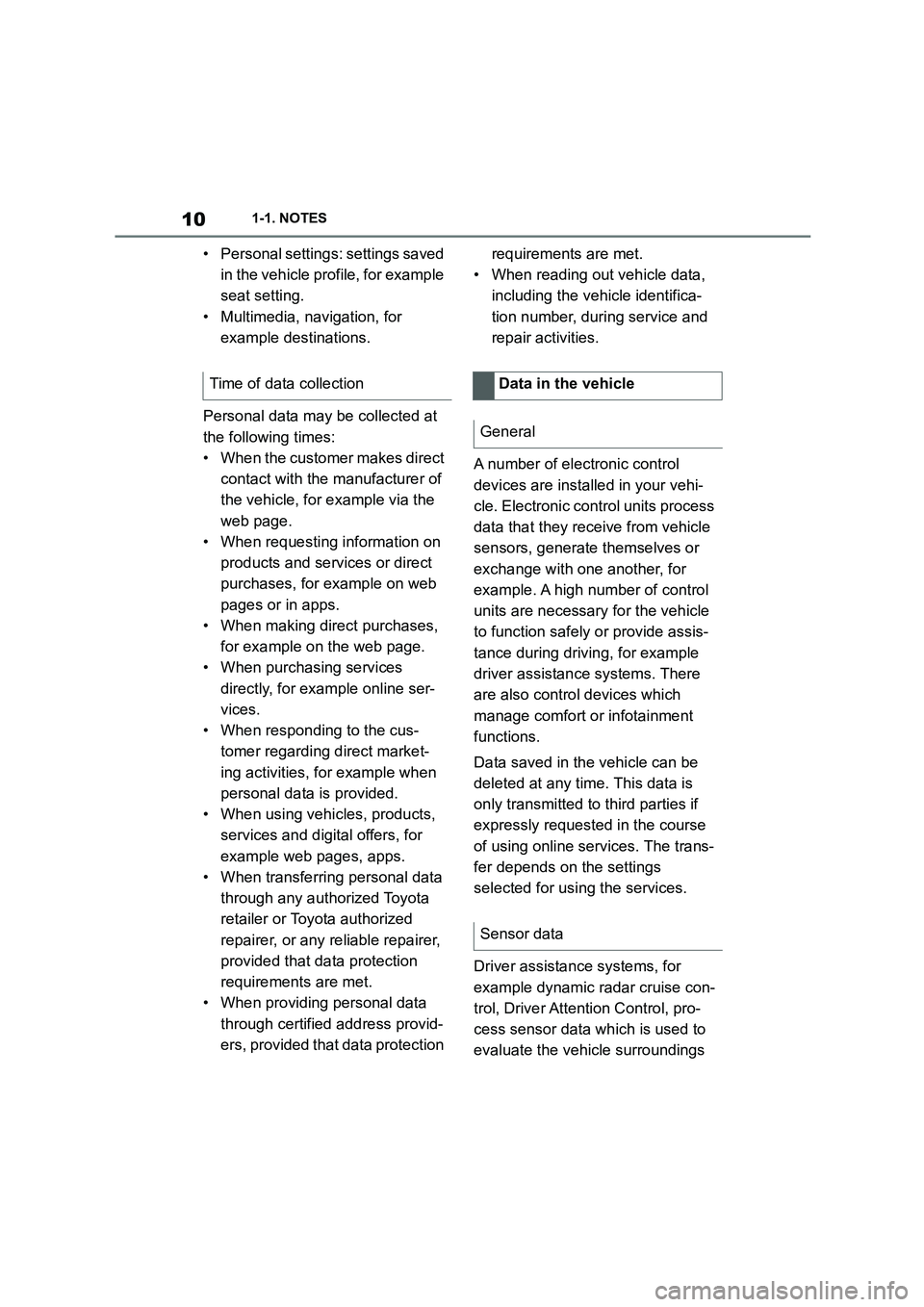
101-1. NOTES
• Personal settings: settings saved
in the vehicle profile, for example
seat setting.
• Multimedia, navigation, for
example destinations.
Personal data may be collected at
the following times:
• When the customer makes direct
contact with the manufacturer of
the vehicle, for example via the
web page.
• When requesting information on
products and services or direct
purchases, for example on web
pages or in apps.
• When making direct purchases,
for example on the web page.
• When purchasing services
directly, for example online ser-
vices.
• When responding to the cus-
tomer regarding direct market-
ing activities, for example when
personal data is provided.
• When using vehicles, products,
services and digital offers, for
example web pages, apps.
• When transferring personal data
through any authorized Toyota
retailer or Toyota authorized
repairer, or any reliable repairer,
provided that data protection
requirements are met.
• When providing personal data
through certified address provid-
ers, provided that data protection
requirements are met.
• When reading out vehicle data,
including the vehicle identifica-
tion number, during service and
repair activities.
A number of electronic control
devices are installed in your vehi-
cle. Electronic control units process
data that they receive from vehicle
sensors, generate themselves or
exchange with one another, for
example. A high number of control
units are necessary for the vehicle
to function safely or provide assis-
tance during driv ing, for example
driver assistance systems. There
are also control devices which
manage comfort or infotainment
functions.
Data saved in the vehicle can be
deleted at any time. This data is
only transmitted to third parties if
expressly requested in the course
of using online services. The trans-
fer depends on the settings
selected for using the services.
Driver assistance systems, for
example dynamic radar cruise con-
trol, Driver Attention Control, pro-
cess sensor data which is used to
evaluate the vehicle surroundings
Time of data collectionData in the vehicle
General
Sensor data
Page 13 of 498
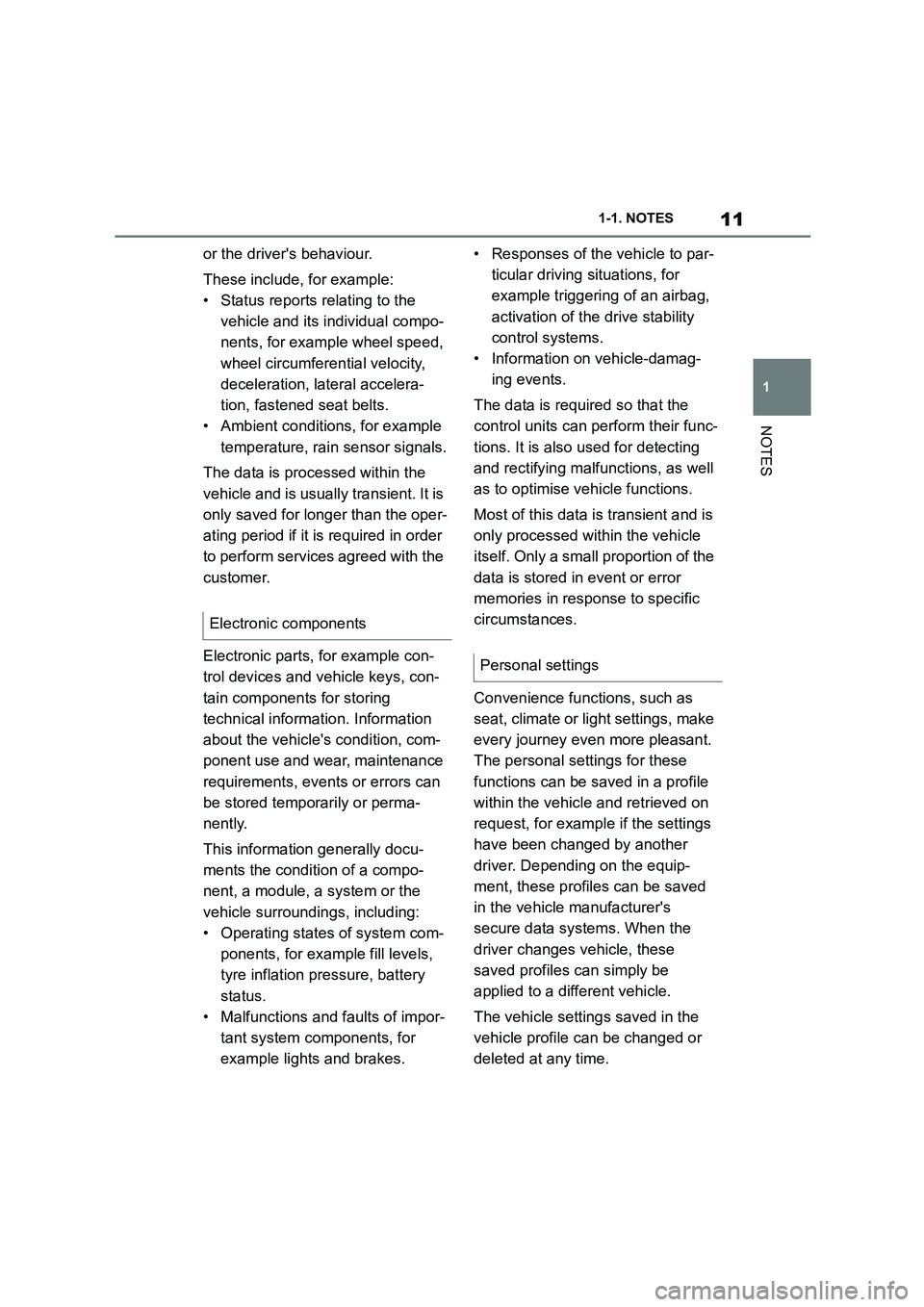
11
1
1-1. NOTES
NOTES
or the driver's behaviour.
These include, for example:
• Status reports relating to the
vehicle and its individual compo-
nents, for example wheel speed,
wheel circumferential velocity,
deceleration, lateral accelera-
tion, fastened seat belts.
• Ambient conditions, for example
temperature, rain sensor signals.
The data is processed within the
vehicle and is usually transient. It is
only saved for longer than the oper-
ating period if it is required in order
to perform services agreed with the
customer.
Electronic parts, for example con-
trol devices and vehicle keys, con-
tain components for storing
technical informat ion. Information
about the vehicle's condition, com-
ponent use and wear, maintenance
requirements, events or errors can
be stored temporarily or perma-
nently.
This information generally docu-
ments the condition of a compo-
nent, a module, a system or the
vehicle surroundings, including:
• Operating states of system com-
ponents, for examp le fill levels,
tyre inflation pr essure, battery
status.
• Malfunctions and faults of impor-
tant system components, for
example lights and brakes.
• Responses of the vehicle to par-
ticular driving situations, for
example triggering of an airbag,
activation of th e drive stability
control systems.
• Information on vehicle-damag-
ing events.
The data is required so that the
control units can perform their func-
tions. It is also used for detecting
and rectifying malfunctions, as well
as to optimise vehicle functions.
Most of this data is transient and is
only processed within the vehicle
itself. Only a small proportion of the
data is stored in event or error
memories in response to specific
circumstances.
Convenience functions, such as
seat, climate or light settings, make
every journey even more pleasant.
The personal settings for these
functions can be saved in a profile
within the vehicle and retrieved on
request, for example if the settings
have been changed by another
driver. Depending on the equip-
ment, these profiles can be saved
in the vehicle manufacturer's
secure data systems. When the
driver changes vehicle, these
saved profiles can simply be
applied to a different vehicle.
The vehicle settings saved in the
vehicle profile can be changed or
deleted at any time.
Electronic components
Personal settings
Page 14 of 498
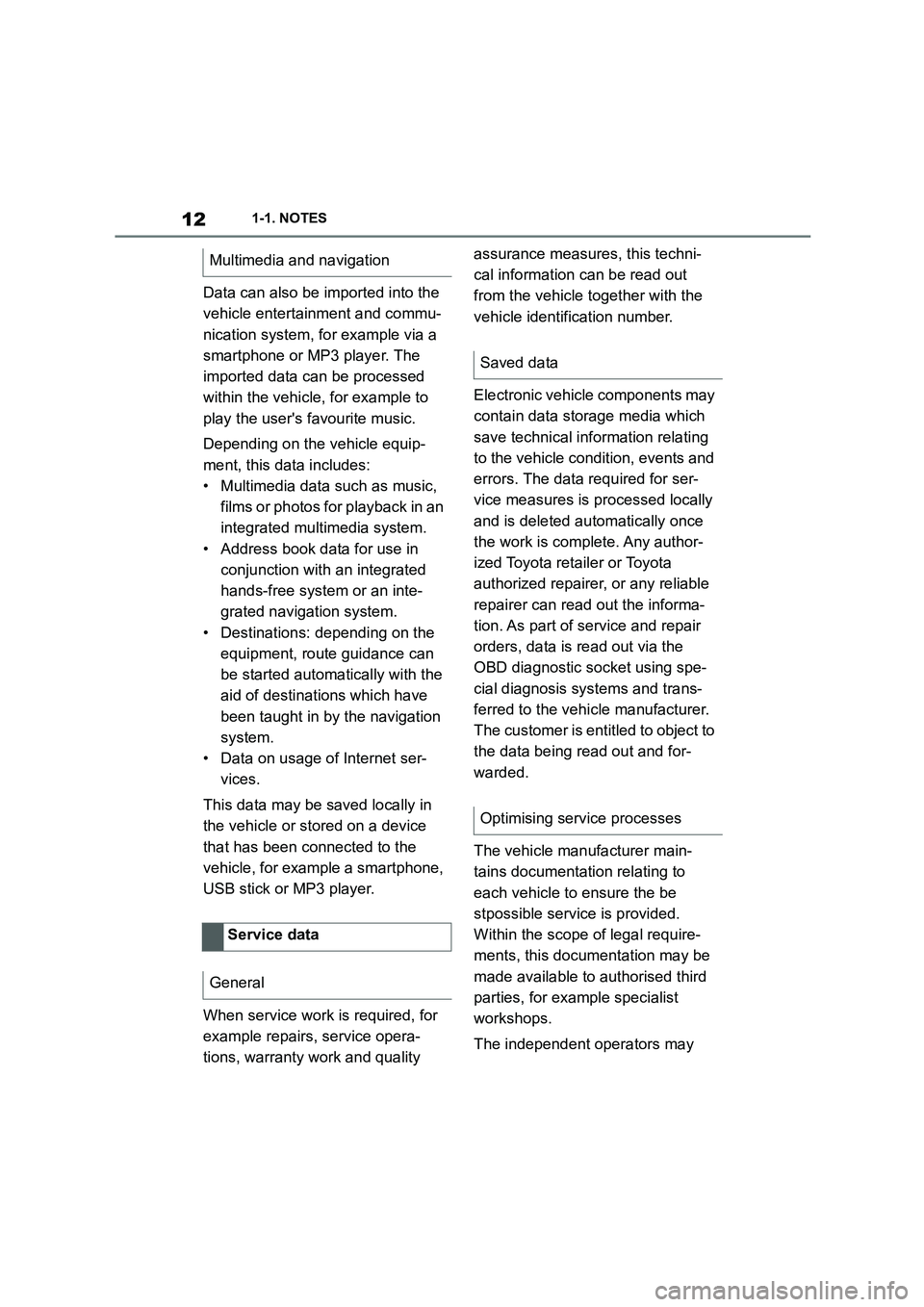
121-1. NOTES
Data can also be imported into the
vehicle entertainment and commu-
nication system, for example via a
smartphone or MP3 player. The
imported data can be processed
within the vehicle, for example to
play the user's favourite music.
Depending on the vehicle equip-
ment, this data includes:
• Multimedia data such as music,
films or photos for playback in an
integrated multimedia system.
• Address book data for use in
conjunction with an integrated
hands-free system or an inte-
grated navigation system.
• Destinations: depending on the
equipment, route guidance can
be started automatically with the
aid of destinations which have
been taught in by the navigation
system.
• Data on usage of Internet ser-
vices.
This data may be saved locally in
the vehicle or stored on a device
that has been connected to the
vehicle, for example a smartphone,
USB stick or MP3 player.
When service work is required, for
example repairs, service opera-
tions, warranty work and quality
assurance measures, this techni-
cal information can be read out
from the vehicle together with the
vehicle identification number.
Electronic vehicle components may
contain data storage media which
save technical info rmation relating
to the vehicle condition, events and
errors. The data required for ser-
vice measures is processed locally
and is deleted au tomatically once
the work is complete. Any author-
ized Toyota retailer or Toyota
authorized repairer, or any reliable
repairer can read out the informa-
tion. As part of service and repair
orders, data is read out via the
OBD diagnostic socket using spe-
cial diagnosis systems and trans-
ferred to the vehicle manufacturer.
The customer is entitled to object to
the data being read out and for-
warded.
The vehicle manufacturer main-
tains documentation relating to
each vehicle to ensure the be
stpossible service is provided.
Within the scope of legal require-
ments, this documentation may be
made available to authorised third
parties, for example specialist
workshops.
The independent operators may
Multimedia and navigation
Service data
General
Saved data
Optimising service processes
Page 15 of 498
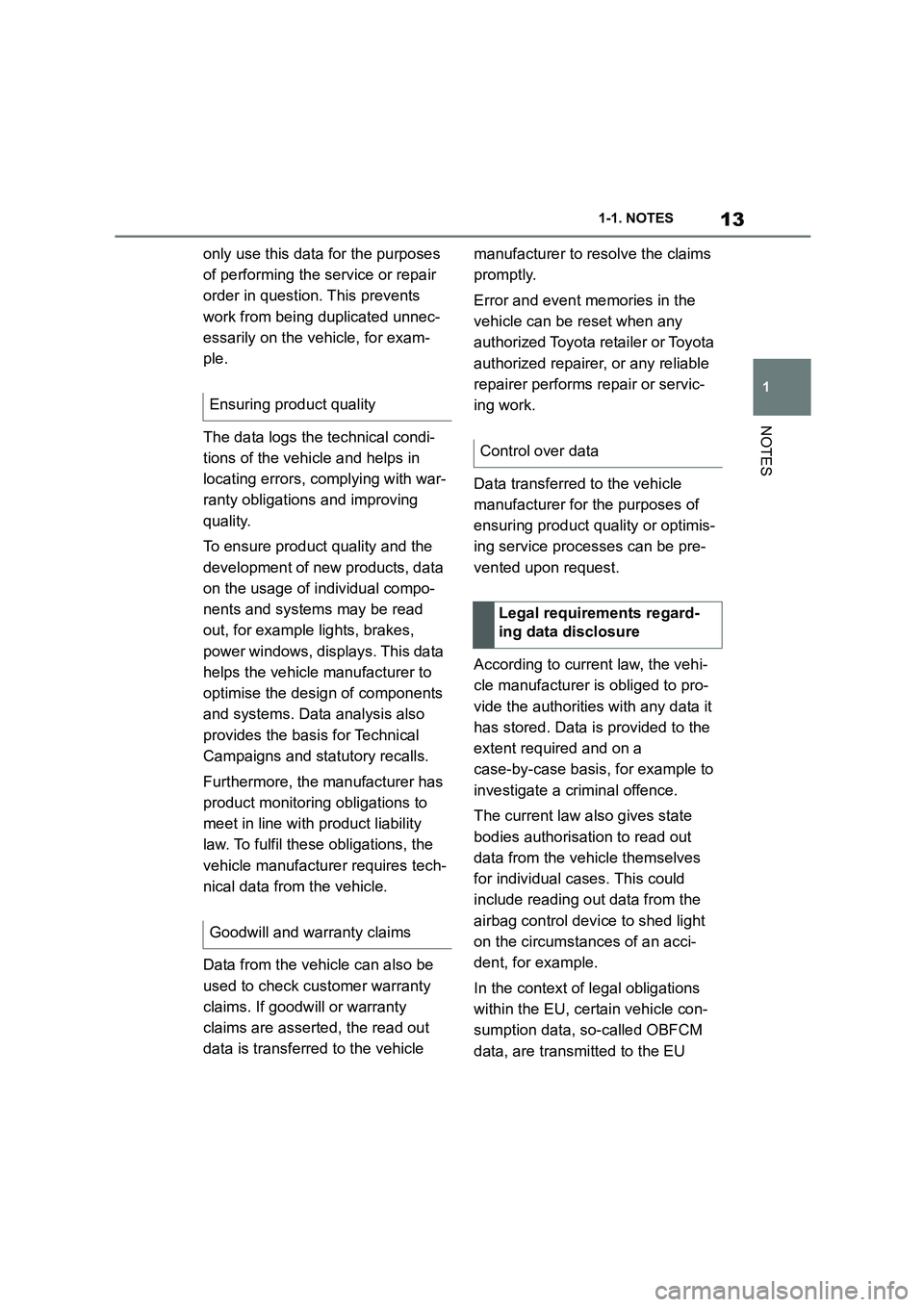
13
1
1-1. NOTES
NOTES
only use this data for the purposes
of performing the service or repair
order in question. This prevents
work from being duplicated unnec-
essarily on the vehicle, for exam-
ple.
The data logs the technical condi-
tions of the vehicle and helps in
locating errors, complying with war-
ranty obligations and improving
quality.
To ensure product quality and the
development of new products, data
on the usage of individual compo-
nents and systems may be read
out, for example lights, brakes,
power windows, displays. This data
helps the vehicle manufacturer to
optimise the design of components
and systems. Data analysis also
provides the basis for Technical
Campaigns and statutory recalls.
Furthermore, the manufacturer has
product monitoring obligations to
meet in line with product liability
law. To fulfil these obligations, the
vehicle manufacturer requires tech-
nical data from the vehicle.
Data from the vehicle can also be
used to check customer warranty
claims. If goodw ill or warranty
claims are asserted, the read out
data is transferred to the vehicle
manufacturer to resolve the claims
promptly.
Error and event memories in the
vehicle can be reset when any
authorized Toyota retailer or Toyota
authorized repairer, or any reliable
repairer performs repair or servic-
ing work.
Data transferred to the vehicle
manufacturer for the purposes of
ensuring product quality or optimis-
ing service processes can be pre-
vented upon request.
According to current law, the vehi-
cle manufacturer is obliged to pro-
vide the authorities with any data it
has stored. Data is provided to the
extent required and on a
case-by-case basis, for example to
investigate a criminal offence.
The current law also gives state
bodies authorisation to read out
data from the vehicle themselves
for individual cases. This could
include reading out data from the
airbag control device to shed light
on the circumstances of an acci-
dent, for example.
In the context of legal obligations
within the EU, certain vehicle con-
sumption data, so-called OBFCM
data, are transmitted to the EU
Ensuring product quality
Goodwill and warr anty claims
Control over data
Legal requirements regard-
ing data disclosure
Page 16 of 498
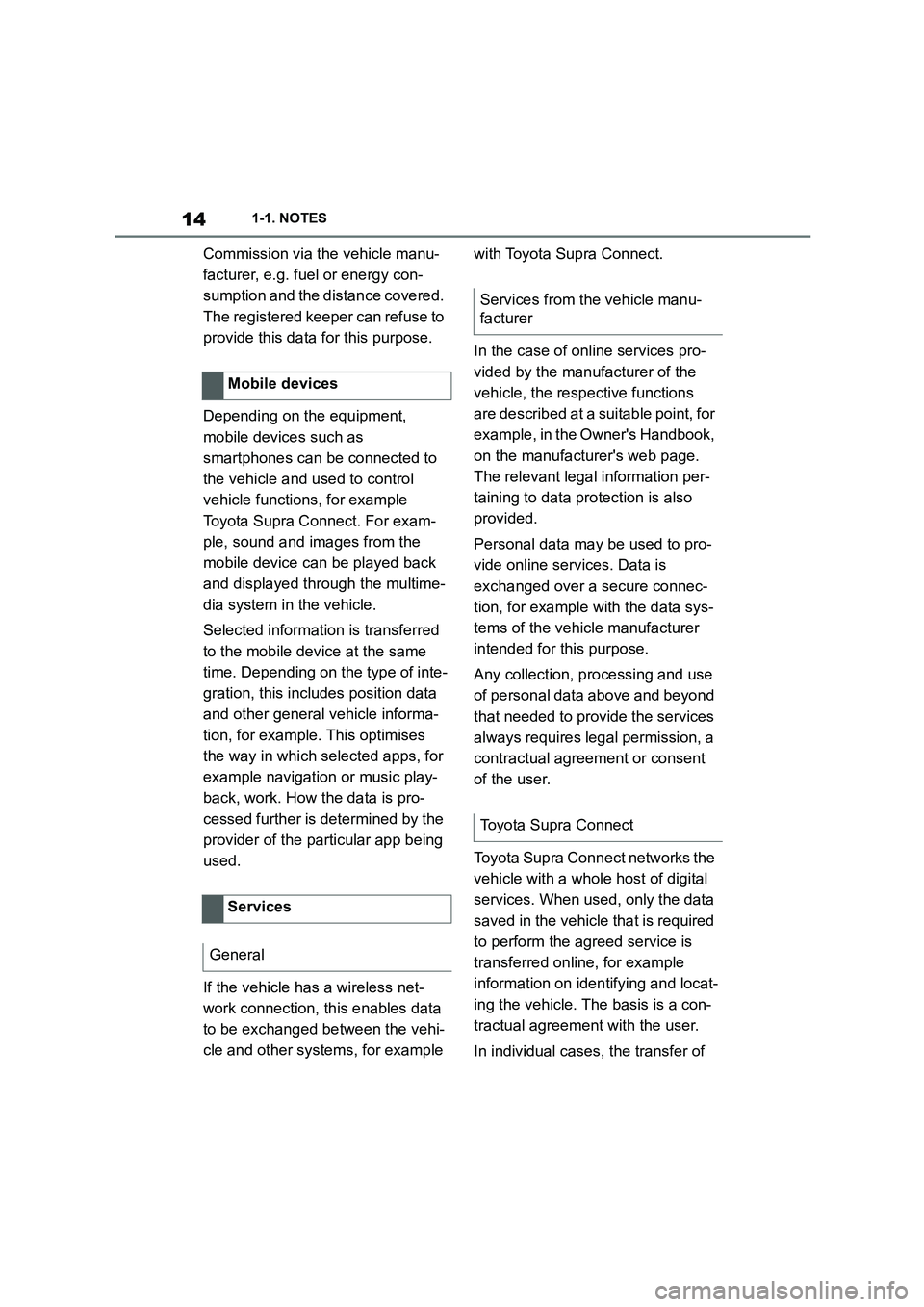
141-1. NOTES
Commission via the vehicle manu-
facturer, e.g. fuel or energy con-
sumption and the distance covered.
The registered keeper can refuse to
provide this data for this purpose.
Depending on the equipment,
mobile devices such as
smartphones can be connected to
the vehicle and used to control
vehicle functions, for example
Toyota Supra Connect. For exam-
ple, sound and images from the
mobile device can be played back
and displayed through the multime-
dia system in the vehicle.
Selected information is transferred
to the mobile device at the same
time. Depending on the type of inte-
gration, this includes position data
and other general vehicle informa-
tion, for example. This optimises
the way in which selected apps, for
example navigation or music play-
back, work. How the data is pro-
cessed further is determined by the
provider of the particular app being
used.
If the vehicle has a wireless net-
work connection, this enables data
to be exchanged between the vehi-
cle and other systems, for example
with Toyota Supra Connect.
In the case of online services pro-
vided by the manufacturer of the
vehicle, the respective functions
are described at a suitable point, for
example, in the Owner's Handbook,
on the manufacturer's web page.
The relevant legal information per-
taining to data protection is also
provided.
Personal data may be used to pro-
vide online services. Data is
exchanged over a secure connec-
tion, for example with the data sys-
tems of the vehicle manufacturer
intended for this purpose.
Any collection, processing and use
of personal data above and beyond
that needed to provide the services
always requires legal permission, a
contractual agreement or consent
of the user.
Toyota Supra Conn ect networks the
vehicle with a whole host of digital
services. When used, only the data
saved in the vehicle that is required
to perform the agreed service is
transferred online, for example
information on iden tifying and locat-
ing the vehicle. The basis is a con-
tractual agreement with the user.
In individual cases, the transfer of
Mobile devices
Services
General
Services from the vehicle manu-
facturer
Toyota Supra Connect
Page 17 of 498
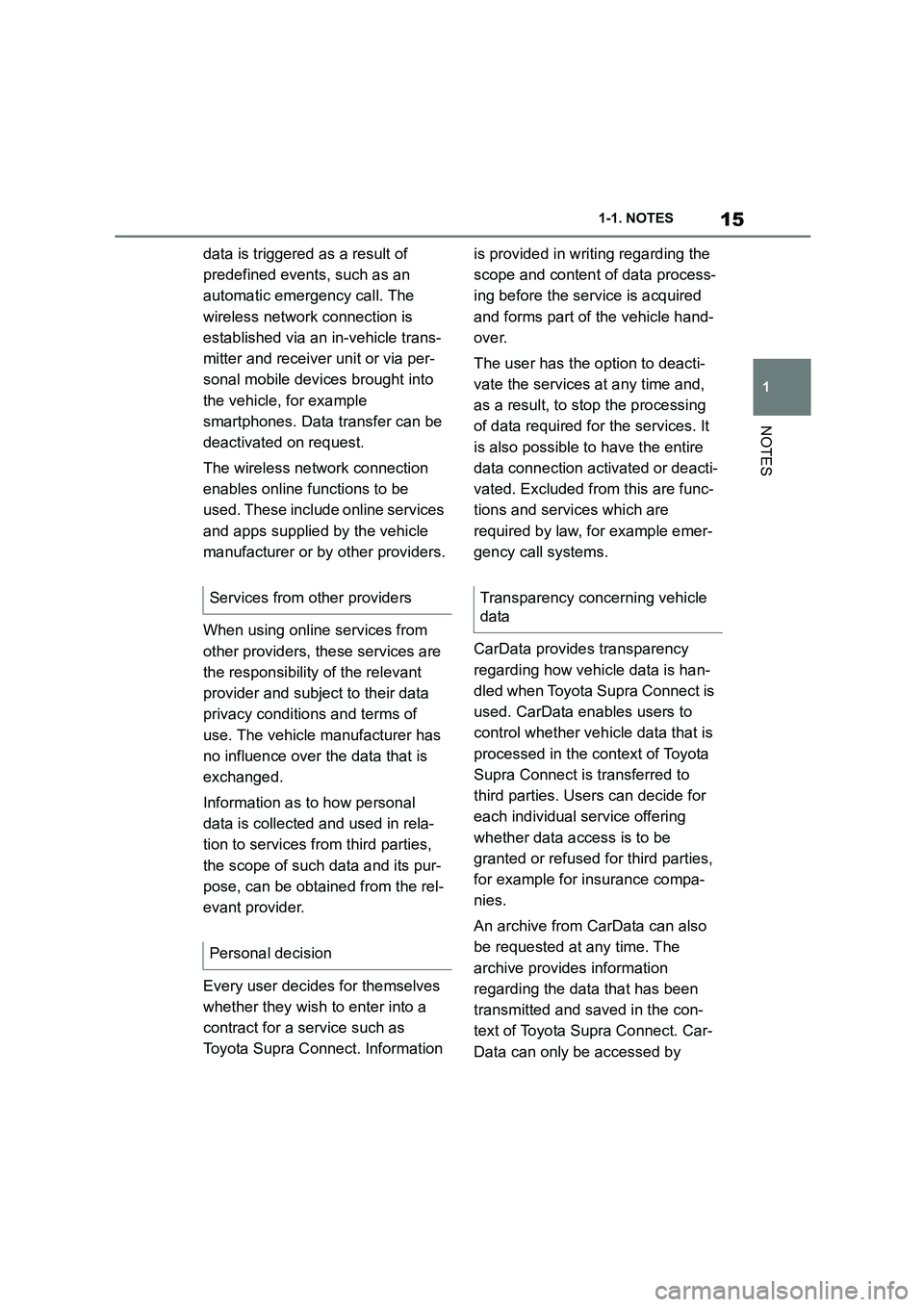
15
1
1-1. NOTES
NOTES
data is triggered as a result of
predefined events, such as an
automatic emergency call. The
wireless network connection is
established via an in-vehicle trans-
mitter and receiver unit or via per-
sonal mobile devices brought into
the vehicle, for example
smartphones. Data transfer can be
deactivated on request.
The wireless network connection
enables online functions to be
used. These include online services
and apps supplied by the vehicle
manufacturer or by other providers.
When using online services from
other providers, these services are
the responsibility of the relevant
provider and subject to their data
privacy conditions and terms of
use. The vehicle manufacturer has
no influence over the data that is
exchanged.
Information as to how personal
data is collected and used in rela-
tion to services from third parties,
the scope of such data and its pur-
pose, can be obtained from the rel-
evant provider.
Every user decides for themselves
whether they wish to enter into a
contract for a service such as
Toyota Supra Connect. Information
is provided in writing regarding the
scope and content of data process-
ing before the service is acquired
and forms part of the vehicle hand-
over.
The user has the option to deacti-
vate the services at any time and,
as a result, to stop the processing
of data required fo r the services. It
is also possible to have the entire
data connection activated or deacti-
vated. Excluded from this are func-
tions and services which are
required by law, for example emer-
gency call systems.
CarData provides transparency
regarding how vehicle data is han-
dled when Toyota Supra Connect is
used. CarData enables users to
control whether vehicle data that is
processed in the context of Toyota
Supra Connect is transferred to
third parties. Users can decide for
each individual service offering
whether data access is to be
granted or refused for third parties,
for example for insurance compa-
nies.
An archive from CarData can also
be requested at any time. The
archive provides information
regarding the data that has been
transmitted and saved in the con-
text of Toyota Supra Connect. Car-
Data can only be accessed by
Services from other providers
Personal decision
Transparency concerning vehicle
data
Page 18 of 498
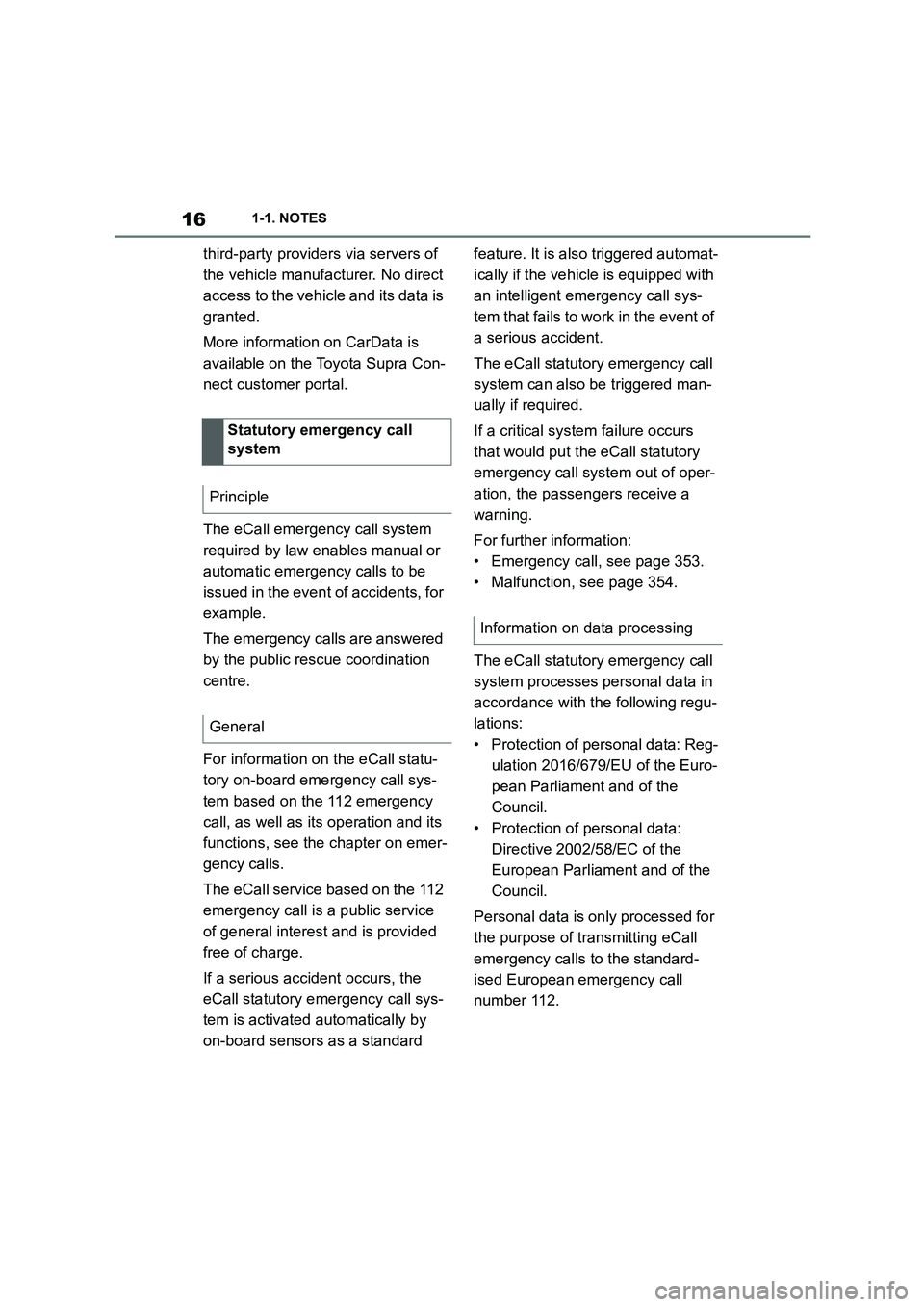
161-1. NOTES
third-party providers via servers of
the vehicle manufacturer. No direct
access to the vehicle and its data is
granted.
More information on CarData is
available on the Toyota Supra Con-
nect customer portal.
The eCall emergency call system
required by law enables manual or
automatic emergency calls to be
issued in the event of accidents, for
example.
The emergency calls are answered
by the public rescue coordination
centre.
For information on the eCall statu-
tory on-board emergency call sys-
tem based on the 112 emergency
call, as well as its operation and its
functions, see the chapter on emer-
gency calls.
The eCall service based on the 112
emergency call is a public service
of general interest and is provided
free of charge.
If a serious accident occurs, the
eCall statutory emergency call sys-
tem is activated automatically by
on-board sensors as a standard
feature. It is also triggered automat-
ically if the vehicle is equipped with
an intelligent emergency call sys-
tem that fails to wo rk in the event of
a serious accident.
The eCall statutory emergency call
system can also be triggered man-
ually if required.
If a critical system failure occurs
that would put the eCall statutory
emergency call system out of oper-
ation, the passengers receive a
warning.
For further information:
• Emergency call, see page 353.
• Malfunction, see page 354.
The eCall statutory emergency call
system processes personal data in
accordance with the following regu-
lations:
• Protection of personal data: Reg-
ulation 2016/679/EU of the Euro-
pean Parliament and of the
Council.
• Protection of personal data:
Directive 2002/58/EC of the
European Parliament and of the
Council.
Personal data is only processed for
the purpose of transmitting eCall
emergency calls to the standard-
ised European emergency call
number 112.
Statutory emergency call
system
Principle
General
Information on data processing
Page 19 of 498
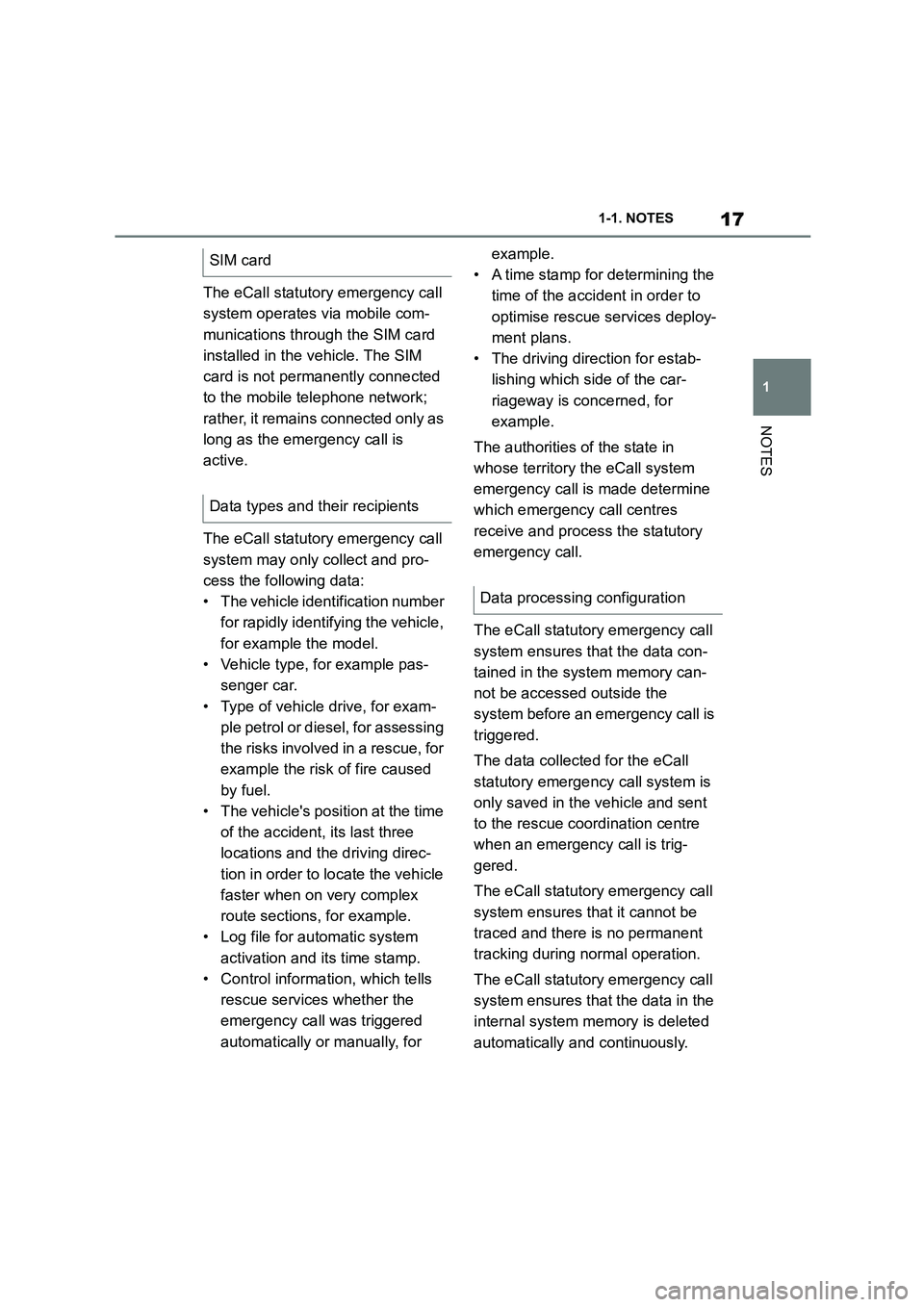
17
1
1-1. NOTES
NOTES
The eCall statutory emergency call
system operates via mobile com-
munications through the SIM card
installed in the vehicle. The SIM
card is not permanently connected
to the mobile telephone network;
rather, it remains connected only as
long as the emergency call is
active.
The eCall statutory emergency call
system may only collect and pro-
cess the following data:
• The vehicle identification number
for rapidly identifying the vehicle,
for example the model.
• Vehicle type, for example pas-
senger car.
• Type of vehicle drive, for exam-
ple petrol or diesel, for assessing
the risks involved in a rescue, for
example the risk of fire caused
by fuel.
• The vehicle's position at the time
of the accident, its last three
locations and the driving direc-
tion in order to locate the vehicle
faster when on very complex
route sections, for example.
• Log file for automatic system
activation and its time stamp.
• Control informat ion, which tells
rescue services whether the
emergency call was triggered
automatically or manually, for
example.
• A time stamp for determining the
time of the accident in order to
optimise rescue services deploy-
ment plans.
• The driving direction for estab-
lishing which side of the car-
riageway is concerned, for
example.
The authorities of the state in
whose territory the eCall system
emergency call is made determine
which emergency call centres
receive and process the statutory
emergency call.
The eCall statutory emergency call
system ensures that the data con-
tained in the system memory can-
not be accessed outside the
system before an emergency call is
triggered.
The data collected for the eCall
statutory emergency call system is
only saved in the vehicle and sent
to the rescue coordination centre
when an emergency call is trig-
gered.
The eCall statutory emergency call
system ensures that it cannot be
traced and there is no permanent
tracking during normal operation.
The eCall statutory emergency call
system ensures that the data in the
internal system memo ry is deleted
automatically and continuously.
SIM card
Data types and their recipients
Data processing configuration
Page 20 of 498
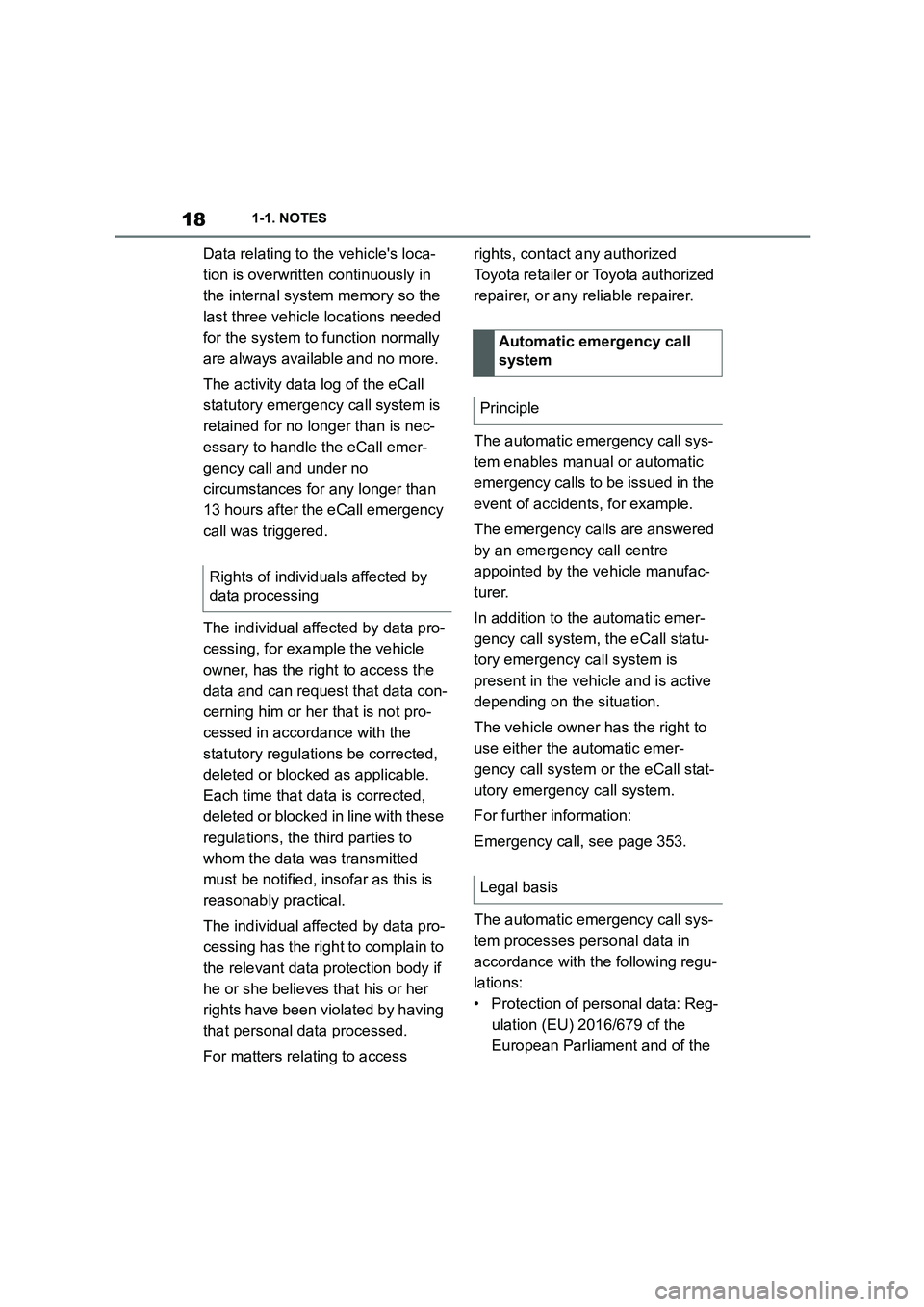
181-1. NOTES
Data relating to the vehicle's loca-
tion is overwritten continuously in
the internal system memory so the
last three vehicle locations needed
for the system to function normally
are always available and no more.
The activity data log of the eCall
statutory emergency call system is
retained for no longer than is nec-
essary to handle the eCall emer-
gency call and under no
circumstances for any longer than
13 hours after the eCall emergency
call was triggered.
The individual affected by data pro-
cessing, for example the vehicle
owner, has the right to access the
data and can request that data con-
cerning him or her that is not pro-
cessed in accordance with the
statutory regulations be corrected,
deleted or blocked as applicable.
Each time that da ta is corrected,
deleted or blocked in line with these
regulations, the third parties to
whom the data was transmitted
must be notified, insofar as this is
reasonably practical.
The individual affected by data pro-
cessing has the righ t to complain to
the relevant data protection body if
he or she believes that his or her
rights have been violated by having
that personal data processed.
For matters relating to access
rights, contact any authorized
Toyota retailer or Toyota authorized
repairer, or any reliable repairer.
The automatic emergency call sys-
tem enables manual or automatic
emergency calls to be issued in the
event of accidents, for example.
The emergency calls are answered
by an emergency call centre
appointed by the vehicle manufac-
turer.
In addition to the automatic emer-
gency call system, the eCall statu-
tory emergency call system is
present in the vehicle and is active
depending on the situation.
The vehicle owner has the right to
use either the automatic emer-
gency call system or the eCall stat-
utory emergency call system.
For further information:
Emergency call, see page 353.
The automatic emergency call sys-
tem processes personal data in
accordance with the following regu-
lations:
• Protection of personal data: Reg-
ulation (EU) 2016/679 of the
European Parliament and of the
Rights of individuals affected by
data processing
Automatic emergency call
system
Principle
Legal basis